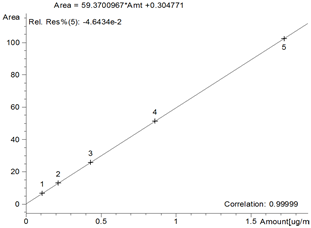QUANTITATIVE DETERMINATION OF THE ALKALOID DONAXIN IN THE SUBSTANCE DONAXINE HYDROCHLORIDE
UDC 615.07
Abstract
The development of analytical methods for the standardization of a substance, as well as dosage forms based on it, is an actual task in the production of pharmacological preparations. In connection with the increasing requirements for the quality of active pharmaceutical ingredients, it is advisable to include modern chromatographic methods (HPLC and GLC) in them. In addition, the prospect of introducing drugs into medical practice determines the need to develop highly sensitive methods for determining active substances in substances for pharmacokinetic studies. The aerial part of Arundo donax L. is the main raw material for the industrial production of the drug substance Donaxin hydrochloride. Donaxin is an alkaloid of the indole group and has the chemical structure of 3-(dimethylaminomethyl) indole. Previously, for the quantitative determination of donaxin hydrochloride in the substance of the drug of the same name, the titrometry method was used, according to the results of which the content of the active substance was at least 98.0%. The aim of this study was to develop and validate a new modern technique that exceeds the titration method in selectivity, reproducibility and precision. We have developed and validated a new method for the quantitative determination of Donaxin hydrochloride using high performance liquid chromatography (HPLC). This technique is simple and well reproduced. The developed method was validated according to the following indicators: specificity, linearity, precision, limit of detection and limit of quantitation. A comparative evaluation of the developed method for the quantitative determination of Donaxin hydrochloride in the substance by HPLC with the method included in the temporary pharmacopoeia article (titrimetric) was carried out in terms of the Fisher criterion.
Downloads
Metrics
References
Analiticheskaya khimiya v sozdanii, standartizatsii i kontrole kachestva lekarstvennykh sredstv. [Analytical chemistry in the creation, standardization and quality control of medicines], ed. V.P. Georgievsky. Kharkov, 2011, vol. 1, 464 p. (in Russ.).
Sakanyan Ye.I., Kovaleva Ye.L., Frolova L.N., Shelestova V.V. Vedomosti Nauchnogo tsentra ekspertizy sredstv med-itsinskogo primeneniya, 2018, vol. 8(3), pp. 170–178. DOI: 10.30895/1991-2919-2018-8-3-170-178. (in Russ.).
Kazakevich Y., Lobrutto R. HPLC for pharmaceutical scientists. New Jersey, 2007, 1135 p.
Grizodub A.I. Farmakom, 2006, no. 1–2, pp. 35–44. (in Russ.).
Ahuja S., Dong M.W. Handbooh of pharmaceutical analysis by HPLC. Amsterdam: Elsevier scince, 2005, 679 p.
Aripova S.F., Khuzhayev V.U., Zhalolov I.Zh., Sagdullayev Sh.Sh. Alkaloidy gigantskogo zlaka Arundo donax L. khimiya, struktura, svoystva, tekhnologiya: monografiya [Alkaloids of the giant cereal Arundo donax L.: chemistry, structure, properties, technology: monograph]. Tashkent, 2017, 256 p. (in Russ.).
Numonov M.A., Sodikov U.Kh. Universum: tekhnicheskiye nauki: elektronnyy nauchnyy zhurnal, 2020, no. 8(77), URL: https://7universum.com/ru/tech/archive/item/10644. (in Russ.).
Al-Snafi A.E. International journal of phytopharmacy research, 2015, vol. 6, no. 1, pp. 34–40.
Shirkani A., Mozaffari M., Zarei M. Iranian south Medical Journal, 2014, vol. 17(1), pp. 49–57.
Khuzhayev V.U., Aripova S.F., Shakirov R.SH. Khimiya proyavleniya soyedineniy, 1994, no. 5, pp. 687–688. (in Russ.).
Mirzayev Yu.R., Sanoyev Z.I., Sadikov A.Z., Aripova S.F., Sagdullayev Sh.Sh., Nigmatullayev B.A., Karimov U.T., Abdullayev N.D., Botirov R.A. Rasmiy akhborotnoma, 2016, no. 1, pp. 17–18. (in Russ.).
Botirov R.A., Mutalova D.K., Sadikov A.Z., Aripova S.F., Sagdullayev Sh.Sh. «Lekarstvennyye preparaty na osnove prirodnykh soyedineniy»: tezisy dokladov mezhdunarodnoy konferentsii. [“Medicines based on natural compounds”: abstracts of reports of the international conference]. Tashkent, 2018, p. 191. (in Russ.).
Khuzhayev V.U. Alkaloidy dikorastushchego i kul'tivirovannogo vida Arundo donax L. stroyeniye novykh osnovaniy: avtoref. diss. … kand. khim. nauk. [Alkaloids of the wild and cultivated species Arundo donax L. structure of new ba-ses: abstract diss. ... cand. chem. sciences]. Tashkent, 1996, 20 p. (in Russ.).
Mirzaev Yu.R., Sanoev Z.I. The Fifth European Conference on Biology and Medical Sciences. Vienna, 2015, pp. 141–145.
Mutalova D.K. i dr. Universum: khimiya i biologiya: elektronnyy nauchnyy zhurnal, 2019, no. 10 (64), URL: https://7universum.com/ru/nature/archive/item/7861. (in Russ.).
Zhdanov D.A., Kurkin V.A., Braslavskiy V.B., Agapov A.I. Razrabotka i registratsiya lekarstvennykh sredstv, 2021, vol. 10(3), pp. 167–175. DOI: 10.33380/2305-2066-2021-10-3-167-175. (in Russ.).
Zhernosek A.K. Farmatsevticheskaya khimiya: prakticheskoye rukovodstvo: uchebno-metodicheskoye posobiye. Ch. 1. [Pharmaceutical chemistry: a practical guide: educational and methodological manual. Part 1]. Vitebsk, 2010. 198 p. (in Russ.).
Berezkin V.G. Zhurnal analiticheskoy khimii, 2008, vol. 63, no. 4, pp. 438–443. (in Russ.).
Novyy spravochnik khimika i tekhnologa. Analiticheskaya khimiya. Ch. II. [New reference book for chemist and tech-nologist. Analytical chemistry. Part II]. St. Petersburg, 2003, 982 p. (in Russ.).
Khokhlova Ye.A., Zdorik A.A., Georgiyants V.A., Vishnevskaya L.I. Khimiya Rastitel'nogo Syr'ya, 2015, no. 2, pp. 195–199. (in Russ.).
Zdoryk O.A., Khokhlova K.O., Savchenko L.P., Georgiyants V.A. The 17-th International Congress Phytopharm. Vi-enna, 2013, p. 51.
Reich E., Schibli A. High-Performance Thin-Layer Chromatography for the Analysis of Medicinal Plants. New York, 2006.
Khokhlova Ye.A., Zdorik A.A., Georgiyants V.A. Khimiya Rastitel'nogo Syr'ya, 2015, no. 1, pp. 133–139. DOI: 10.14258/jcprm.201501397. (in Russ.).

Copyright (c) 2023 chemistry of plant raw material

This work is licensed under a Creative Commons Attribution 4.0 International License.

This work is licensed under a Creative Commons Attribution 4.0 International License.
The authors, which are published in this journal, agree to the following conditions:
1. Authors retain the copyright to the work and transfer to the journal the right of the first publication along with the work, at the same time licensing it under the terms of the Creative Commons Attribution License, which allows others to distribute this work with the obligatory indication of the authorship of this work and a link to the original publication in this journal .
2. The authors retain the right to enter into separate, additional contractual agreements for the non-exclusive distribution of the version of the work published by this journal (for example, to place it in the university depository or to publish it in a book), with reference to the original publication in this journal.
3. Authors are allowed to post their work on the Internet (for example, in a university repository or on their personal website) before and during the review process of this journal, as this may lead to a productive discussion, as well as more links to this published work.











